인공영양을 먹이는 데 필요한 것들, Things needed for infant formula feeding
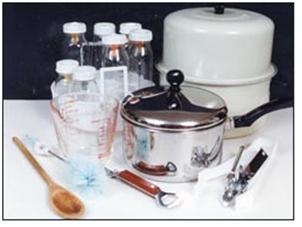
사진 3-2. 인공영양을 먹이는 데 필요로 하는 것들.
Copyright ⓒ 2011 John Sangwon Lee, MD., FAAP
- 아기에게 먹일 인공영양의 종류에 따라 인공영양을 먹이는데 필요한 것들이 조금씩 다르다.
- 분만하기 전 아기에게 인공영양을 먹이기로 결정됐으면 다음과 같은 것들을 분만 전 준비하면 분만 후 인공영양을 먹일 때 요긴하게 쓸 수 있다.
- 모유를 수유할 때는 가끔 인공영양을 보충용으로 먹여야 할 때가 있다.
- 그래서 그런 처지를 대비하기 위해 인공영양을 먹이는 데 필요한 것들을 준비 해 놓을 수 있다.
-
- 우유병을 끓여 멸균 처리할 수 있는 뚜껑 달린 큰 냄비 하나
- 우유병을 걸어 놓을 수 있는 시렁 하나
- 물 용량을 측정할 수 있는 물 측정 컵 하나
- 캔 오프너(깡통 따개) 하나
- 15cc 정도의 물을 측정할 수 있는 큰 수저 하나
- 우유병, 우유병 뚜껑과 젖병 꼭지 각각 8~12개
- 우유병과 젖병 꼭지를 깨끗이 씻을 수 있는 크고 작은 솔 각각 하나
- 소독한 우유병들과 젖병 꼭지들을 냄비 속에서 꺼낼 수 있는 집게 하나
- 아기에게 며칠 내지 1주일 동안 먹일 수 있는 인공영양
- 그 외
| 우유병(젖병) |
Milk bottles
- 인공영양을 먹일 때 쓰는 병을 우유병, 또는 젖병이라고 부른다.
- 사실은, 우유를 신생아나 영유아에게 먹이지 않기 때문에 우유병이란 말 대신 인공영양 병, 포물라 병, 또는 그 외 다른 말을 쓰는 것이 좋을 것이다. 그러나 펴의상 여기서도 우유병이란 말을 그대로 쓰기로 한다. 때로는 젖병이란 말도 쓴다.
- 대부분의 우유병은 유리나 플라스틱, 또는 폴리카보네이트 등으로 만든다.
- 인공영양을 먹는 아기의 나이와 체중에 따라 우유병의 크기도 모양도 다를 수 있다.
- 아주 작은 미숙아에게 인공영양을 먹일 때 쓸 수 있는 특수 우유병도 있다.
- 15~30cc 인공영양을 담아 먹일 수 있을 정도로 작고 마치 큰 주사기 통과 비슷하게 생긴 우유병도 있다.
- 건강한 만삭 신생아들이나 영아들에게 인공영양을 먹일 때는 120~240cc 인공영양을 담을 수 있는 크기의 우유병이면 된다.
- 120~240cc 인공영양을 담을 수 있는 우유병을 8개 정도 있으면 된다.
- 요즘 우유병은 각양각색으로 만든다.
- 심지어는 예쁜 그림도 우유병에 있다.
- 어떤 우유병은 가볍고 잘 깨지지도 않아 몇 달 또는 몇 년 동안 오랫동안 쓸 수 있다.
- 플라스틱이나 폴리카보네이트로 만든 어떤 우유병은 오랫동안 쓰면 병이 불투명해진다.
- 먹다 남은 인공영양의 찌꺼기가 우유병 속안 벽에 붙어 깨끗이 씻기 어렵다.
- 병 바닥이 없는 우유병도 있다.
- 이런 병으로 인공영양을 먹일 때는 먹일 때마다 플라스틱 주머니 속에 인공영양을 담아서 그 플라스틱 주머니를 유유병 속에 넣어 인공영양을 먹인다.
- 다 먹인 후 그 플라스틱 주머니만 버리면 된다.
- 유리로 만든 우유병은 플라스틱으로 만든 우유병에 비교해 투명하고 우유병 속 벽에 붙어있는 인공영양의 찌꺼기를 씻어내기가 더 쉽다.
- 그러나 쉽게 깨질 수 있는 것이 단점이다.
- 플라스틱으로 만든 우유병이든 유리로 만든 우유병이든 병 속을 쉽게 볼 수 있고, 쉽게 씻을 수 있고, 우유 찌꺼기가 잘 붙지 않고 뚜렷한 눈금이 있는 우유병이면 다 괜찮다.
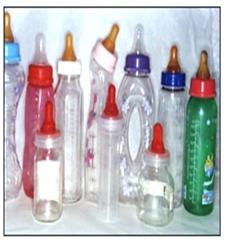
사진 3-3. 여러 종류의 우유병.
Copyright ⓒ 2011 John Sangwon Lee, MD., FAAP
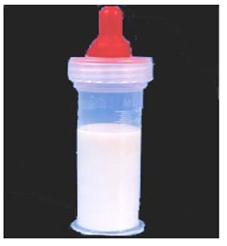
사진 3-4. 신생아용 우유병.
Copyright ⓒ 2011 John Sangwon Lee, MD., FAAP
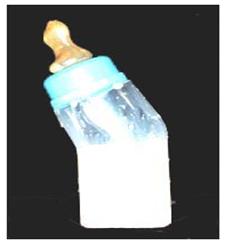
사진 3-5. 재미있고 먹이기에 편리하게 만든 삐딱한 우유병.
Copyright ⓒ 2011 John Sangwon Lee, MD., FAAP
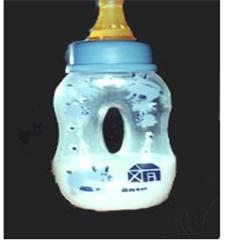
사진 3-6. 재미있고 흥미롭게 만든 우유병.
Copyright ⓒ 2011 John Sangwon Lee, MD., FAAP

사진 3-7. 보기 좋게 그린 사진이 있는 우유병.
Copyright ⓒ 2011 John Sangwon Lee, MD., FAAP
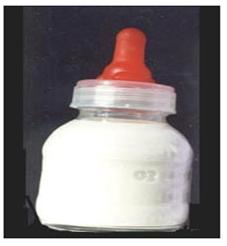
사진 3-8. 병원 신생아실에서 주로 쓰는 신생아용 우유병.
Copyright ⓒ 2011 John Sangwon Lee, MD., FAAP
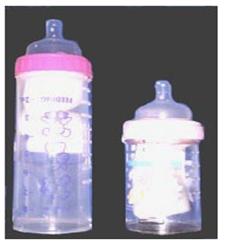
사진 3-9. 병 바닥이 없는(병 밑이 없는) 우유병.
이런 종류의 우유병으로 인공영양을 먹일 때는 1회용 플라스틱 백 속에 인공영양을 담은 후 인공영양을 먹인다.
Copyright ⓒ 2011 John Sangwon Lee, MD., FAAP
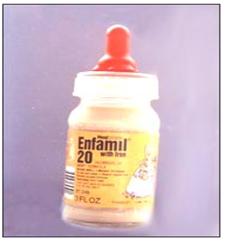
사진 3-10. 주로 병원 신생아실에서 미숙싱새아나 만삭 신생아에게 인공영양을 먹일 때 사용하는 신생아용 인공영양과 우유병.
Copyright ⓒ 2011 John Sangwon Lee, MD., FAAP
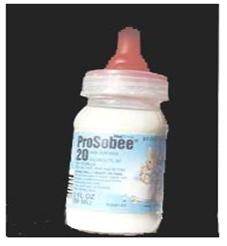
사진 3-11. 주로 병원 신생아실에서 미숙아 신생아나 만삭 신생아에게 인공영양을 먹일 때 사용하는 신생아용 인공영양과 우유병.
Copyright ⓒ 2011 John Sangwon Lee, MD., FAAP
| 우유병 꼭지, 우유병 마개(우유병 뚜껑 또는 젖병 마개) |
Rubber nipples, Feeding bottle nipples, Baby bottle nipples, Milk bottle cap
- 아기들이 우유병 속에 들어있는 인공영양을 빨아먹을 때 쓰는 꼭지를 고무 젖꼭지, 젖병 꼭지, 젖병 꼭지 또는 우유병 꼭지라고 한다.
- 인공 젖꼭지, 또는 포물라 젖꼭지 등의 말로 바꿔 쓰는 것이 좋을 것이다.
- 여기에선 우유병 꼭지란 말을 주로 쓰기로 한다.
- 오늘 날 인공영양을 먹이기 위해 흔히 쓰는 “고무 젖꼭지”는 고무성분으로 만들어져 있지도 않고 플라스틱이나, 실리콘, 또는 레이텍스 성분 등으로 만들어져 있다.
- 인공영양을 우유병으로 먹일 때 우유병 꼭지를 우유병 마개에 끼워 쓴다.
- 유방에 있는 엄마의 젖꼭지와 인공영양을 먹을 때 젖병 뚜껑에 꽂아 쓰는 우유병 꼭지를 구별하는 새 용어가 필요한 것 같다.
- 만든 재료에 따라 플라스틱 우유병 꼭지, 고무 우유병 꼭지, 또는 레이텍스 우유병 꼭지 등으로 불러야할 것 같다.
- 고무 우유병 꼭지의 형태, 모양, 크기에도 여러 가지가 있다.
- 아기의 나이와 크기에 따라 크고 작은 고무 우유병 꼭지를 선택해서 쓴다.
- 아기 입의 해부학적 구조에 더 알맞게 만든 특수 우유병 꼭지도 있다.
- 예를 들면 언청이나 구개파열이 있는 아기에 인공영양을 먹일 때 특별하게 만든 우유병 꼭지도 있다.
- 새로 산 우유병 꼭지를 처음 쓰기 전에 우유병 꼭지에 뚫린 구멍의 크기가 적절한 크기로 뚫려 있는지 다음과 같이 검사해야 한다.
- 우유병 속에 먹을 만큼 인공영양을 붓고 새로 산 우유병 꼭지를 낀 우유병 마개로 우유병을 꼭 닫는다.
- 그 다음 우유병을 거꾸로 잠시 동안 들고 있는다.
- 그 때 우유병 속의 인공영양이 새로 산 우유병 꼭지에 있는 구멍을 통해서 한 방울씩 한 방울씩 연속적으로 떨어지면 그 구멍의 크기가 알맞다.
- 우유병을 거꾸로 들고 있는 동안 우유병 꼭지의 구멍을 통해 인공영양이 오줌줄기 같이 주르륵 계속 쏟아져 나오면 우유병 꼭지 구멍의 크기가 너무 큰 것이고 부적절한 우유병 꼭지이다.
- 우유병을 거꾸로 들고 있을 때 인공영양이 우유병 꼭지 구멍을 통해 병 속 인공영양이 잘 흘러나오지 않을 때도 있다.
- 이 때 우유병을 살살 흔들면 인공영양이 한두 방울씩 떨어지기도 한다. 이 경우 우유병 꼭지의 구멍 크기가 너무 작은 것이고 그 우유병 꼭지는 부적절한 것이다.
- 새 것을 처음 쓸 때는 새 우유병 꼭지의 구멍이 알맞게 뚫려 있을지라도 그 우유병 꼭지를 오랫동안 쓰면 구멍의 크기가 더 이상 써서는 안 될 정도로 점점 더 커질 수 있다.
- 특히 이가 난 이후부터는 아기들은 젖꼭지를 이로 물고 당기기도 한다.
- 그래서 젖꼭지가 손상되기 쉽고 구멍이 더 커질 수 있다.
- 아기에게 인공영양을 먹일 때 우유병 꼭지 구멍의 크기가 적절한지 자주 점검해야 한다.
- 구멍이 부적절하면 알맞은 우유병 꼭지로 바로 바꿔야 한다.

사진 3-12. 여러 종류의 우유병 꼭지.
Copyright ⓒ 2011 John Sangwon Lee, MD., FAAP

사진 3-13.유유병 꼭지와 우유병 마개.
Copyright ⓒ 2011 John Sangwon Lee, MD., FAAP
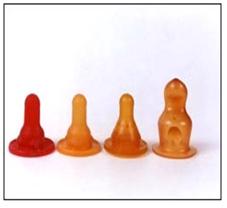
사진 3-14. 우유병 꼭지,
Copyright ⓒ 2011 John Sangwon Lee, MD., FAAP
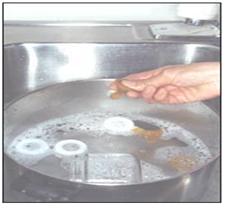
사진 3-15. 우유병 꼭지만 깨끗이 씻든지 다른 것과 같이 깨끗이 씻는다.
Copyright ⓒ 2011 John Sangwon Lee, MD., FAAP
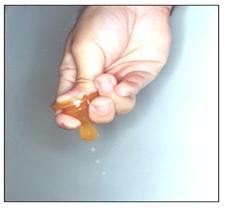
사진 3-16. 우유병 꼭지의 구멍도 잘 씻는다. 구멍의 크기가 적당한 가 체크한다.
Copyright ⓒ 2011 John Sangwon Lee, MD., FAAP
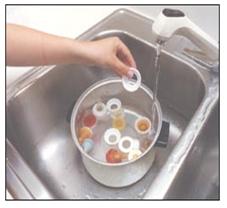
사진 3-17. 우유병 꼭지와 젖병 마개 등을 깨끗이 씻는다.
Copyright ⓒ 2011 John Sangwon Lee, MD., FAAP
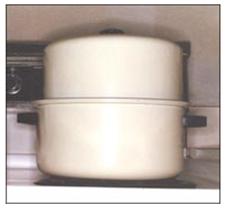
사진 3-18. 깨끗이 씻은 우유병 꼭지와 젖병 마개를 냄비에 넣고 끓여 멸균처리한다.
Copyright ⓒ 2011 John Sangwon Lee, MD., FAAP

사진 3-19. 우유병 꼭지를 잘 씻고 물에 끓여 멸균처리한다.
Copyright ⓒ 2011 John Sangwon Lee, MD., FAAP

사진 3-20. 잘 씻고 끓여 멸균처리한 젖꼭지를 보관했다가 쓸 때마다 하나씩 꺼내 쓴다.
Copyright ⓒ 2011 John Sangwon Lee, MD., FAAP

사진 3-21. 끓여 멸균 처리된 우유병 꼭지를 가능한 한 손으로 만지지 않는다.
Copyright ⓒ 2011 John Sangwon Lee, MD., FAAP
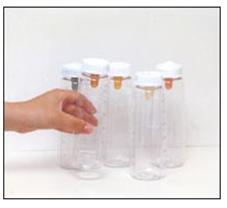
사진 3-22.우유병 꼭지와 젖병 마개로 사진에서 보는 것과 같이 젖병을 막아 보관했다 필요에 따라 쓴다.
Copyright ⓒ 2011 John Sangwon Lee, MD., FAAP
| 우유병, 우유병 꼭지와 우유병 뚜껑의 세척 |
Cleaning of milk bottles, rubber nipples, bottle covers(bottle caps)
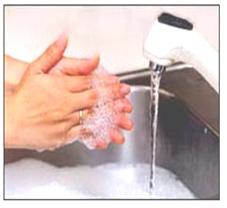
사진 3-23. 우선 손을 깨끗이 씻는다.
Copyright ⓒ 2011 John Sangwon Lee, MD., FAAP
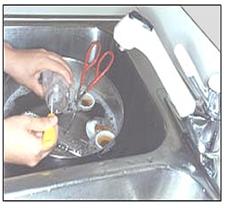
사진 3-24. 우유병, 우유병 꼭지, 젖병뚜껑(젖병 마게) 등을 세정제를 탄 따뜻한 물로 씻고 필요에 따라 솔로 더 깨끗이 씻는다.
Copyright ⓒ 2011 John Sangwon Lee, MD., FAAP

사진 3-25 .우유병 꼭지 반대쪽에 있는 우유병 꼭지 부분을 손가락으로 눌러 짜서 우유병 꼭지 구멍을 깨끗이 씻는다.
Copyright ⓒ 2011 John Sangwon Lee, MD., FAAP
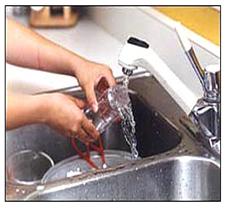
사진 3-26. 흐르는 물로 우유병(젖병)과 우유병 꼭지를 헹군다.
Copyright ⓒ 2011 John Sangwon Lee, MD., FAAP
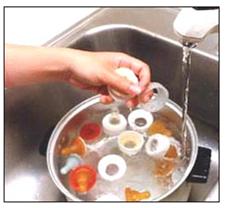
사진 3-27. 우유병의 바깥과 뚜껑도 깨끗이 씻는다.
Copyright ⓒ 2011 John Sangwon Lee, MD., FAAP
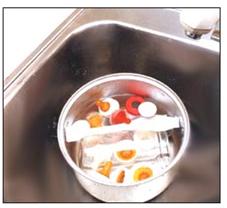
사진 3-28. 우유병 꼭지, 우유병, 우유병 뚜껑, 집게 등을 냄비 속에 넣고 잠길 정도 물을 붓는다.
Copyright ⓒ 2011 John Sangwon Lee, MD., FAAP
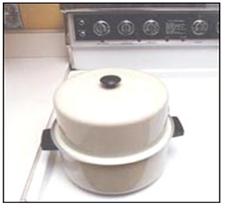
사진 3-29. 냄비 뚜껑을 닫고 5 분 동안 끓여 멸균 소독한다.
Copyright ⓒ 2011 John Sangwon Lee, MD., FAAP
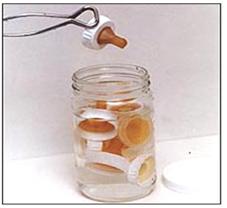
사진 3-30. 끓여 멸균 소독한 우유병 꼭지를 멸균 소독된 큰 병 속에 보관했다가 필요에 따라 꺼내 쓴다.
Copyright ⓒ 2011 John Sangwon Lee, MD., FAAP
Things needed for infant formula feeding 인공영양을 먹이는 데 필요한 것들

Photo 3-2. What you need to feed artificial nutrition. Copyright ⓒ 2011 John Sangwon Lee, MD., FAAP
- Depending on the type of artificial nutrition to feed your baby, the things you need to feed your baby are slightly different.
- If you decide to feed your baby with artificial nutrition before delivery, the following can be useful when feeding artificial nutrition after delivery if you prepare before the delivery.
- When breastfeeding, it is sometimes necessary to supplement artificial nutrition.
- So, in order to prepare for such a situation, you can prepare what you need to feed artificial nutrition.
- One large pot with lid to boil and sterilize milk bottles
- One cache to hang a bottle of milk
- One measuring cup of water to measure water capacity
- One can opener
- One large spoon that can measure 15cc of water
- 8 to 12 milk bottles,
- bottle caps
- One large and small brush for cleaning the bottle and bottle nipples
- One tong to take out the sterilized milk bottles and the bottle nipples from the pot
- Artificial nutrition that you can feed your baby for days to weeks etc
- Milk bottle (baby bottle)
Milk bottles
- The bottle used to feed artificial nutrition is called a milk bottle or baby bottle.
- In fact, since milk is not fed to newborns or infants, it would be better to use a bottle of artificial nutrition, or something else instead of a bottle of milk. However, I will use the word milk bottle as it is here in the costume.
- Sometimes the word is used as a baby bottle.
- Most milk bottles are made of glass, plastic, or polycarbonate.
- Depending on the age and weight of an artificial nutrient-fed baby, the size and shape of the milk bottle can be different.
- There are also special bottles of milk that can be used when feeding artificial nutrition to very small premature babies.
- There are also bottles of milk that are small enough to be fed with 15 to 30 cc artificial nutrients that resemble a large syringe bottle.
- When feeding artificial nutrition to healthy term newborns or infants, a milk bottle sized to hold 120-240cc artificial nutrition is sufficient.
- You only need about 8 milk bottles that can contain 120~240cc artificial nutrition. These days, milk bottles are made in various ways. Even pretty pictures are in the milk bottle.
- Some milk bottles are light and hard to break, so they can last for months or years. Some milk bottles made of plastic or polycarbonate become opaque after prolonged use.
- Artificial nutrient residue leftover from eating sticks to the inner wall of the milk bottle and is difficult to clean.
- Some milk bottles have no bottom. When feeding artificial nutrition with such a bottle, the artificial nutrition is put in a plastic bag every time it is fed, and the plastic bag is placed in a milk bottle to feed artificial nutrition. When you’re done feeding, you just need to throw away the plastic bag.
- Glass milk bottles are transparent and easier to wash away the artificial nutrient debris stuck to the wall inside the milk bottle compared to plastic milk bottles. However, the disadvantage is that it can be easily broken.
- Whether it’s a plastic bottle or a glass bottle, it’s all right if it’s easy to see inside the bottle, is easy to wash, doesn’t stick to milk residue, and has a clear scale.

Photo 3-3. Different types of milk bottles. Copyright ⓒ 2011 John Sangwon Lee, MD., FAAP

Photo 3-4. Baby bottle. Copyright ⓒ 2011 John Sangwon Lee, MD., FAAP

Photo 3-5. A stiff milk bottle made for fun and convenient feeding. Copyright ⓒ 2011 John Sangwon Lee, MD., FAAP

Photo 3-6. A fun and interesting milk bottle. Copyright ⓒ 2011 John Sangwon Lee, MD., FAAP

Photo 3-7. A milk bottle with nicely painted pictures. Copyright ⓒ 2011 John Sangwon Lee, MD., FAAP

Photo 3-8. A newborn baby bottle is used mainly in hospital neonatal rooms. Copyright ⓒ 2011 John Sangwon Lee, MD., FAAP

Photo 3-9. A milk bottle with no bottom (without bottom of the bottle). When feeding artificial nutrition with this kind of milk bottle, feed artificial nutrition after containing the artificial nutrition in a disposable plastic bag. Copyright ⓒ 2011 John Sangwon Lee, MD., FAAP

Photo 3-10. Artificial nutrition and milk bottles for newborns, which are mainly used to feed artificial nutrition to immature or term newborns in the hospital neonatal room. Copyright ⓒ 2011 John Sangwon Lee, MD., FAAP

Photo 3-11. Artificial nutrition and milk bottles for newborns used to feed artificial nutrition to premature newborns or term newborns in the neonatal room of a hospital. Copyright ⓒ 2011 John Sangwon Lee, MD., FAAP
Milk bottle cap (bottle cap), Rubber nipples,
- Feeding bottle nipples, Baby bottle nipples, Milk bottle cap
- The nipple that babies use to suck up the artificial nutrients in the milk bottle is called a pacifier, a bottle nipple, a baby bottle nipple, or a milk bottle nipple.
- It would be better to use artificial nipples or formula nipples.
- Here, I will mainly use the word milk bottle cap.
- “Rubber pacifiers”, which are commonly used today to feed artificial nutrition, are not made of rubber but are made of plastic, silicone, or latex.
- When feeding artificial nutrients with a milk bottle, put the bottle cap on the bottle cap. It seems that a new term is needed to distinguish between the mother’s nipple in the breast and the milk bottle nipple that is inserted into the bottle cap when eating artificial nutrients.
- Depending on the material made, it may be called plastic milk bottle cap, rubber milk bottle cap, or latex milk bottle cap.
- There are many different shapes, shapes, and sizes of rubber milk bottle nipples.
- Depending on the baby’s age and size, choose a small and large rubber milk bottle nipple.
- There is also a special milk bottle nipple made to better fit the anatomy of the baby’s mouth. For example, there is also a special milk bottle teat when feeding artificial nutrition to a baby with a cold or cleft palate.
- Before using the new bottle cap for the first time, you should check the size of the hole in the bottle cap to ensure that it is the appropriate size.
- Pour artificial nutrition enough to eat into the milk bottle and close the milk bottle with the bottle cap with the new bottle cap. Then hold the bottle upside down for a while.
- At that time, if the artificial nutrients in the milk bottle fall continuously, drop by drop, through the hole in the top of the newly bought milk bottle, the size of the hole is appropriate. If artificial nutrients continue to pour out like urine through the hole in the bottle cap while holding the bottle upside down, the size of the bottle cap hole is too large and is inappropriate.
- When holding the milk bottle upside down, artificial nutrients in the bottle may not flow out well through the bottle cap hole. At this time, if the milk bottle is gently shaken, artificial nutrients may drop by a drop or two. In this case, the size of the hole in the bottle cap is too small and the bottle cap is inappropriate.
- The first time you use a new bottle, even if the hole in the top of the new bottle is properly drilled, the size of the hole can grow to a point where it should no longer be used over a long period of time.
- In particular, after having a tooth, babies can bite and pull the nipple with their teeth. So the nipples are more susceptible to damage and the holes can be larger. When feeding your baby with artificial nutrients, you should check frequently to make sure the size of the bottle tip hole is appropriate. If the hole is inadequate, it should be replaced immediately with a suitable milk bottle cap.

Photo 3-12. Different types of milk bottle caps. Copyright ⓒ 2011 John Sangwon Lee, MD., FAAP

Photo 3-13. The bottle cap and the bottle stopper. Copyright ⓒ 2011 John Sangwon Lee, MD., FAAP

Photo 3-14. Milk bottle faucet, Copyright ⓒ 2011 John Sangwon Lee, MD., FAAP

Photo 3-15. Just wash the bottle head, or wash it like any other. Copyright ⓒ 2011 John Sangwon Lee, MD., FAAP

Photo 3-16. Wash the hole in the top of the milk bottle. Check if the size of the hole is appropriate. Copyright ⓒ 2011 John Sangwon Lee, MD., FAAP

Photo 3-17. Wash the bottle caps and bottle caps thoroughly. Copyright ⓒ 2011 John Sangwon Lee, MD., FAAP

Photo 3-18. Put the cleansed milk bottle cap and bottle cap in a pot and boil it for sterilization. Copyright ⓒ 2011 John Sangwon Lee, MD., FAAP

Photo 3-19. Wash the teapot of the milk bottle and boil it in water to sterilize it. Copyright ⓒ 2011 John Sangwon Lee, MD., FAAP

Photo 3-20. Store the sterilized nipples by washing and boiling them well. Copyright ⓒ 2011 John Sangwon Lee, MD., FAAP

Photo 3-21. Avoid touching the boiled and sterilized milk bottle cap with your hands as much as possible. Copyright ⓒ 2011 John Sangwon Lee, MD., FAAP

Picture 3-22. The bottle is closed and stored as shown in the picture with the bottle cap and bottle cap. Use as necessary. Copyright ⓒ 2011 John Sangwon Lee, MD., FAAP
Cleaning of the bottle and bottle cap, Cleaning of milk bottles, rubber nipples, bottle covers (bottle caps)

Photo 3-23. First, wash your hands thoroughly. Copyright ⓒ 2011 John Sangwon Lee, MD., FAAP

Photo 3-24. Wash the milk bottle, and bottle cap with warm water with a detergent, and wash more thoroughly with a brush if necessary. Copyright ⓒ 2011 John Sangwon Lee, MD., FAAP

Picture 3-25. Wash the hole in the bottle cap by pressing the milk bottle cap on the opposite side of the milk bottle cap with your finger and squeezing it. Copyright ⓒ 2011 John Sangwon Lee, MD., FAAP

Photo 3-26. Rinse the bottle and bottle cap with running water. Copyright ⓒ 2011 John Sangwon Lee, MD., FAAP

Photo 3-27. Wash the outside and lid of the bottle. Copyright ⓒ 2011 John Sangwon Lee, MD., FAAP

Photo 3-28. Put the milk bottle cap, milk bottle, and tongs into the pot and pour enough water to submerge it. Copyright ⓒ 2011 John Sangwon Lee, MD., FAAP

Photo 3-29. Cover the pot and boil for 5 minutes to sterilize. Copyright ⓒ 2011 John Sangwon Lee, MD., FAAP

Photo 3-30. Store the boiled and sterilized milk bottle in a large sterilized bottle and take it out as needed. Copyright ⓒ 2011 John Sangwon Lee, MD., FAAP
출처 및 참조 문헌
- NelsonTextbook of Pediatrics 22ND Ed
- The Harriet Lane Handbook 22ND Ed
- Growth and development of the children
- Red Book 32nd Ed 2021-2024
- Pediatric Nutritional Handbook American Academy of Pediatrics
- 소아가정간호백과–부모도 반의사가 되어야 한다, 이상원 저
- The pregnancy Bible. By Joan stone, MD. Keith Eddleman, MD
- Neonatology Jeffrey J.Pomerance, C. Joan Richardson
- Preparation for Birth. Beverly Savage and Dianna Smith
- 임신에서 신생아 돌보기까지. 이상원
- Breastfeeding. by Ruth Lawrence and Robert Lawrence
- Pediatric Nutritional Handbook American Academy of Pediatrics
- 소아가정간호백과–부모도 반의사가 되어야 한다, 이상원 저
- The pregnancy Bible. By Joan stone, MD. Keith Eddleman,MD
- Neonatology Jeffrey J.Pomerance, C. Joan Richardson
- Preparation for Birth. Berverly Savage and Dianna Smith
- 임신에서 신생아 돌보기까지. 이상원
- Breastfeeding. by Ruth Lawrence and Robert Lawrence
-
- www.drleepediatrics.com 제1권 소아청소년 응급 의료
- www.drleepediatrics.com 제2권 소아청소년 예방
- www.drleepediatrics.com 제3권 소아청소년 성장 발육 육아
- www.drleepediatrics.com 제4권 모유,모유수유, 이유
- www.drleepediatrics.com 제5권 인공영양, 우유, 이유식, 비타민, 미네랄, 단백질, 탄수화물, 지방
- www.drleepediatrics.com 제6권 신생아 성장 발육 육아 질병
- www.drleepediatrics.com제7권 소아청소년 감염병
- www.drleepediatrics.com제8권 소아청소년 호흡기 질환
- www.drleepediatrics.com제9권 소아청소년 소화기 질환
- www.drleepediatrics.com제10권. 소아청소년 신장 비뇨 생식기 질환
- www.drleepediatrics.com제11권. 소아청소년 심장 혈관계 질환
- www.drleepediatrics.com제12권. 소아청소년 신경 정신 질환, 행동 수면 문제
- www.drleepediatrics.com제13권. 소아청소년 혈액, 림프, 종양 질환
- www.drleepediatrics.com제14권. 소아청소년 내분비, 유전, 염색체, 대사, 희귀병
- www.drleepediatrics.com제15권. 소아청소년 알레르기, 자가 면역질환
- www.drleepediatrics.com제16권. 소아청소년 정형외과 질환
- www.drleepediatrics.com제17권. 소아청소년 피부 질환
- www.drleepediatrics.com제18권. 소아청소년 이비인후(귀 코 인두 후두) 질환
- www.drleepediatrics.com제19권. 소아청소년 안과 (눈)질환
- www.drleepediatrics.com 제20권 소아청소년 이 (치아)질환
- www.drleepediatrics.com 제21권 소아청소년 가정 학교 간호
- www.drleepediatrics.com 제22권 아들 딸 이렇게 사랑해 키우세요
- www.drleepediatrics.com 제23권 사춘기 아이들의 성장 발육 질병
- www.drleepediatrics.com 제24권 소아청소년 성교육
- www.drleepediatrics.com 제25권 임신, 분만, 출산, 신생아 돌보기
- Red book 29th-31st edition 2021
- Nelson Text Book of Pediatrics 19th- 21st Edition
- The Johns Hopkins Hospital, The Harriet Lane Handbook, 22nd edition
- 응급환자관리 정담미디어
-
소아가정간호백과–부모도 반의사가 되어야 한다, 이상원
-
Neonatal Resuscitation American heart Association
-
Neonatology Jeffrey J.Pomerance, C. Joan Richardson
-
Pediatric Resuscitation Pediatric Clinics of North America, Stephen M. Schexnayder, M.D.
-
Pediatric Critical Care, Pediatric Clinics of North America, James P. Orlowski, M.D.
-
Preparation for Birth. Beverly Savage and Dianna Smith
-
Infectious disease of children, Saul Krugman, Samuel L Katz, Ann A. Gershon, Catherine Wilfert
- Pediatric Nutritional Handbook American Academy of Pediatrics
- 소아가정간호백과–부모도 반의사가 되어야 한다, 이상원
- The pregnancy Bible. By Joan stone, MD. Keith Eddleman, MD
- Neonatology Jeffrey J. Pomerance, C. Joan Richardson
- Preparation for Birth. Beverly Savage and Dianna Smith
- 임신에서 신생아 돌보기까지. 이상원
- Breastfeeding by Ruth Lawrence and Robert Lawrence
- Infectious disease of children, Saul Krugman, Samuel L Katz, Ann A. Gershon, Catherine Wilfert
- 제4권 모유, 모유수유, 이유 참조문헌 및 출처
- 제5권 인공영양, 우유, 이유, 비타민, 단백질, 지방 탄수 화물 참조문헌 및 출처
- 제6권 신생아 성장발육 양호 질병 참조문헌 및 출처
- 소아과학 대한교과서
Copyright ⓒ 2014 John Sangwon Lee, MD., FAAP
“부모도 반의사가 되어야 한다”-내용은 여러분들의 의사로부터 얻은 정보와 진료를 대신할 수 없습니다.
“The information contained in this publication should not be used as a substitute for the medical care and advice of your doctor. There may be variations in treatment that your doctor may recommend based on individual facts and circumstances.
“Parental education is the best medicine.